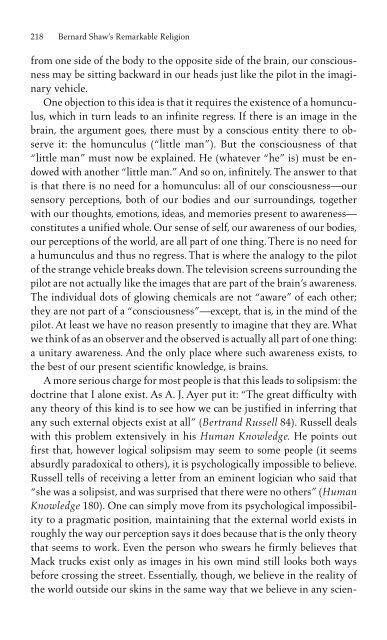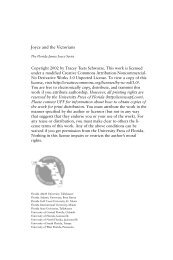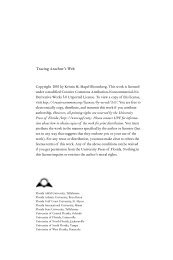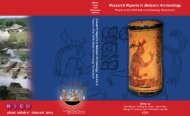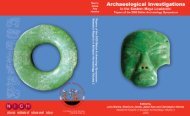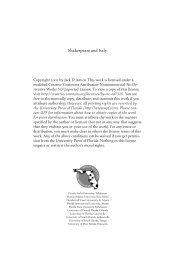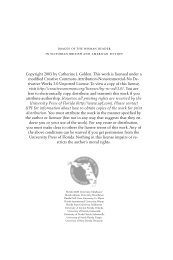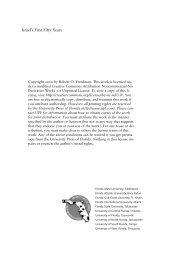Bernard Shaw's Remarkable Religion: A Faith That Fits the Facts
Bernard Shaw's Remarkable Religion: A Faith That Fits the Facts
Bernard Shaw's Remarkable Religion: A Faith That Fits the Facts
Create successful ePaper yourself
Turn your PDF publications into a flip-book with our unique Google optimized e-Paper software.
218 <strong>Bernard</strong> Shaw’s <strong>Remarkable</strong> <strong>Religion</strong><br />
from one side of <strong>the</strong> body to <strong>the</strong> opposite side of <strong>the</strong> brain, our consciousness<br />
may be sitting backward in our heads just like <strong>the</strong> pilot in <strong>the</strong> imaginary<br />
vehicle.<br />
One objection to this idea is that it requires <strong>the</strong> existence of a homunculus,<br />
which in turn leads to an infinite regress. If <strong>the</strong>re is an image in <strong>the</strong><br />
brain, <strong>the</strong> argument goes, <strong>the</strong>re must by a conscious entity <strong>the</strong>re to observe<br />
it: <strong>the</strong> homunculus (“little man”). But <strong>the</strong> consciousness of that<br />
“little man” must now be explained. He (whatever “he” is) must be endowed<br />
with ano<strong>the</strong>r “little man.” And so on, infinitely. The answer to that<br />
is that <strong>the</strong>re is no need for a homunculus: all of our consciousness—our<br />
sensory perceptions, both of our bodies and our surroundings, toge<strong>the</strong>r<br />
with our thoughts, emotions, ideas, and memories present to awareness—<br />
constitutes a unified whole. Our sense of self, our awareness of our bodies,<br />
our perceptions of <strong>the</strong> world, are all part of one thing. There is no need for<br />
a humunculus and thus no regress. <strong>That</strong> is where <strong>the</strong> analogy to <strong>the</strong> pilot<br />
of <strong>the</strong> strange vehicle breaks down. The television screens surrounding <strong>the</strong><br />
pilot are not actually like <strong>the</strong> images that are part of <strong>the</strong> brain’s awareness.<br />
The individual dots of glowing chemicals are not “aware” of each o<strong>the</strong>r;<br />
<strong>the</strong>y are not part of a “consciousness”—except, that is, in <strong>the</strong> mind of <strong>the</strong><br />
pilot. At least we have no reason presently to imagine that <strong>the</strong>y are. What<br />
we think of as an observer and <strong>the</strong> observed is actually all part of one thing:<br />
a unitary awareness. And <strong>the</strong> only place where such awareness exists, to<br />
<strong>the</strong> best of our present scientific knowledge, is brains.<br />
A more serious charge for most people is that this leads to solipsism: <strong>the</strong><br />
doctrine that I alone exist. As A. J. Ayer put it: “The great difficulty with<br />
any <strong>the</strong>ory of this kind is to see how we can be justified in inferring that<br />
any such external objects exist at all” (Bertrand Russell 84). Russell deals<br />
with this problem extensively in his Human Knowledge. He points out<br />
first that, however logical solipsism may seem to some people (it seems<br />
absurdly paradoxical to o<strong>the</strong>rs), it is psychologically impossible to believe.<br />
Russell tells of receiving a letter from an eminent logician who said that<br />
“she was a solipsist, and was surprised that <strong>the</strong>re were no o<strong>the</strong>rs” (Human<br />
Knowledge 180). One can simply move from its psychological impossibility<br />
to a pragmatic position, maintaining that <strong>the</strong> external world exists in<br />
roughly <strong>the</strong> way our perception says it does because that is <strong>the</strong> only <strong>the</strong>ory<br />
that seems to work. Even <strong>the</strong> person who swears he firmly believes that<br />
Mack trucks exist only as images in his own mind still looks both ways<br />
before crossing <strong>the</strong> street. Essentially, though, we believe in <strong>the</strong> reality of<br />
<strong>the</strong> world outside our skins in <strong>the</strong> same way that we believe in any scien-


